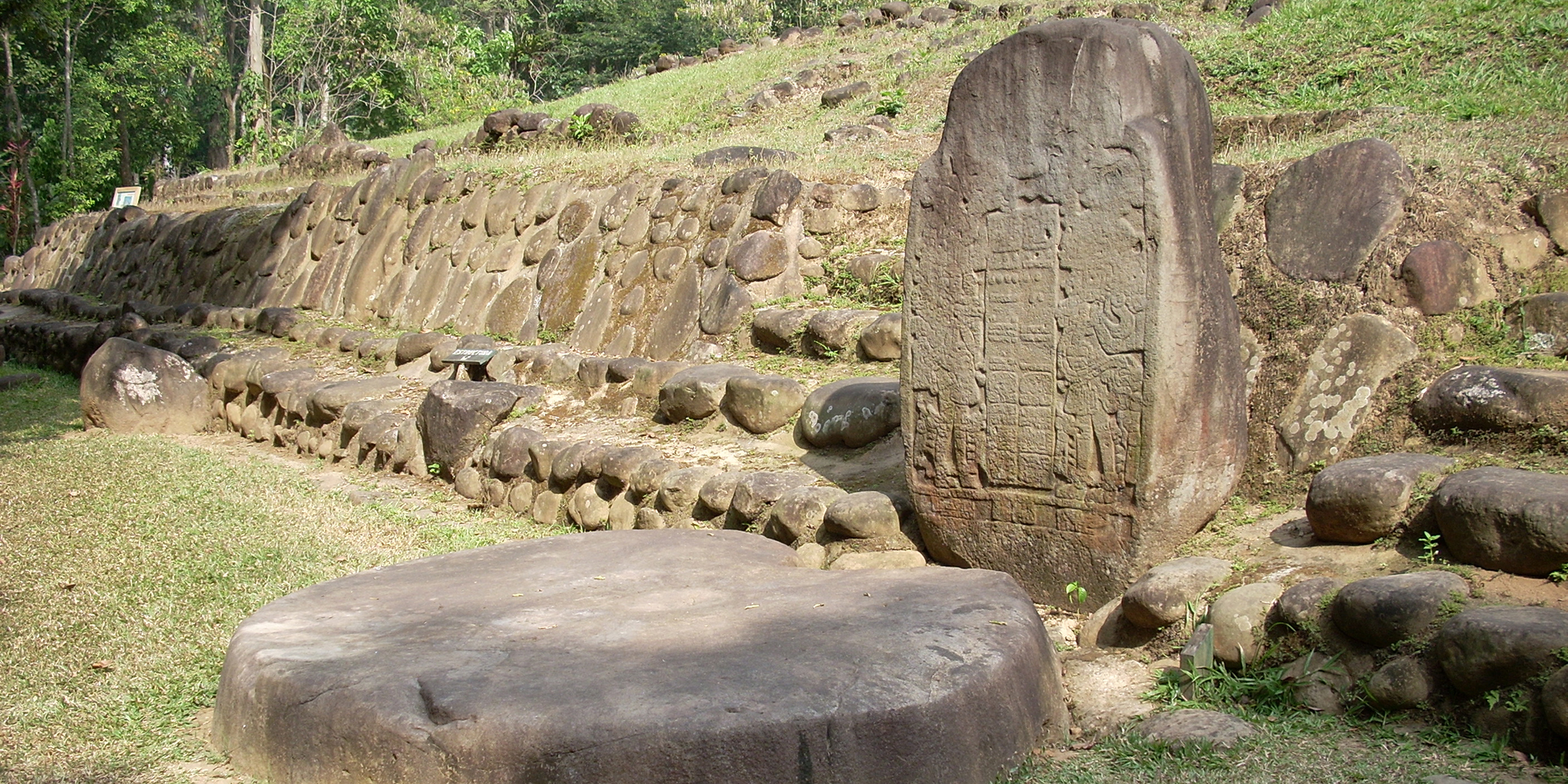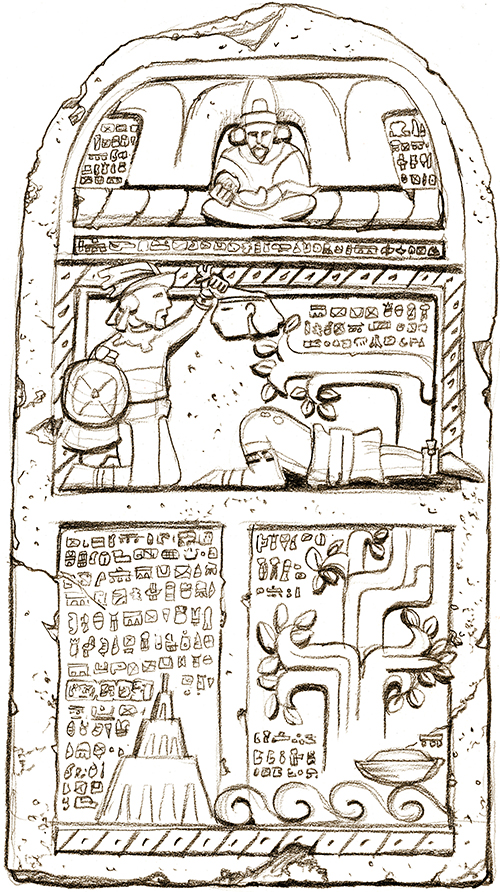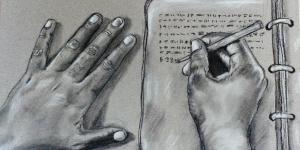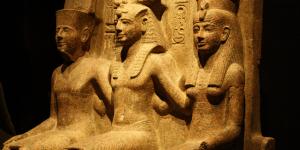You are here
Why was Coriantumr's Record Engraved on a "Large Stone"?

Omni 1:20
The Know
When the people of Zarahemla met the elder Mosiah, they showed him a “large stone … with engravings on it” which Mosiah was able to interpret “by the gift and power of God.” The stone “gave an account of one Coriantumr, and the slain of his people,” and also “spake a few words concerning his fathers” and related the origin of the Jaredites “from the tower” (Omni 1:20–22).
Early Latter-day Saints living in Nauvoo were interested to learn that explorers John Lloyd Stephens and Fredrick Catherwood had discovered a large, engraved stone among the ruins of Quiriguá in Guatemala. In October 1842, with Joseph Smith at the helm as editor, the Times and Seasons reported, “that a large stone with engravings upon it” had been found by Stephens, “among the left remembrances of the, (to him), lost and unknown.”1 This was seen as favorable evidence for the Book of Mormon by these first generation Mormons.
Today, the large carved stones, called stelae (singular, stela), of the Maya and other Mesoamerican cultures are well known. Brant A. Gardner explained, “Mesoamerica is unique in the Western Hemisphere for its writing systems. … Part of that tradition includes inscriptions on stelae, or large stones.”2 These were called lakam-tuun by the Maya, which literally meant “large stone,” just as it is in Omni 1:20.3 LDS Mesoamericanists Mark Wright and Kerry Hull have both pointed out the potential significance of this connection.4
Comparing and contrasting the content on stelae with other writing media in the Mesoamerican area, John L. Sorenson explained:
The other large class of documents of which we know consisted of inscribed stones. Those too typically were written in double columns. Again some human figure or a more complex historical or mythological scene would be presented. Sometimes it was the texts that were primary, and the art secondary, and at other times, the reverse.5
Most stelae were meant to memorialize the king and his accomplishments.6 Mesoamerican art historians Maline D. Werness-Rude and Kaylee R. Spencer said, “Stelae most often depict the visages of a king,” and that “stelae must be seen … as historical records of past activities.” They added,
Inscriptions carved on the sides and often the backs of the sculptures specifically anchor the ruler’s actions within time and space. They also often name particular gods and ancestors …. Both text and iconography create parallels between the sitter’s actions and those of past kings and queens—ancestors whose activities other stelae … recount.7
The origin of this practice began with the Olmec, a culture in mesoamerica contemporary with the Jaredites.8 By 400 BC stelae typically focused on a king or ruler, depicting him as a warrior, providing a record of his actions, and listing off the ruler’s ancestors.9 These details are broadly consistent with the brief description given in Omni 1:20–22.10
The Why
The monumental inscriptions of Mesoamerica were not widely known in the United States until after Stephens and Catherwood published their findings in 1841.11 The excitement in and around Nauvoo over their findings in 1842 indicates that Joseph Smith and early Latter-day Saints were most likely unaware of things like stone inscriptions found in the Americas previously.
Even as awareness of Mesoamerican stelae grew, the inscriptions remained undecipherable, and as such the understanding of their contents was limited. Before the 1960s, most scholars believed that Mesoamerican monuments had no historical content whatsoever, but exclusively depicted and described gods and myths.12 Yet the Book of Mormon described a “large stone” engraved with the history of a king, his battles, his ancestors, and the origins of his ruling lineage.
Today, it is easy to take for granted the evidence for large stone monuments from Mesoamerica and assume it is of little or no significance for the Book of Mormon. Such an attitude, however, fails to appreciate how unknown the practice was in Joseph Smith’s own time and the fact that it took 130–160 years for linguists and epigraphers to catch up with Amaleki’s description in Omni 1:20–22.13
The more scholars learn about Mesoamerican stelae, the more comfortably Coriantumr’s stela fits the description. This is one instance where archaeology now strongly supports the Book of Mormon, whereas it did not seem to before. Realizing this underscores the importance of patience when it comes to comparing a text like the Book of Mormon to the archaeological record.14
Further Reading
Brant A. Gardner, Second Witness: Analytical and Contextual Commentary on the Book of Mormon, 6 vols. (Salt Lake City, UT: Greg Kofford Books, 2007–2008), 3:64–65.
Daniel Johnson, Jared Cooper, and Derek Glasser, An LDS Guide to Mesoamerica (Springville, UT: Cedar Fort, 2008), 55–59 (sidebar).
John L. Sorenson, “The Book of Mormon as a Mesoamerican Codex,” in Book of Mormon Authorship Revisited: The Evidence for Ancient Origins, ed. Noel B. Reynolds (Provo, UT: FARMS, 1996), 412–418.
- 1. “Zarahemla,” Times and Seasons 3, no. 23 (October 1842): 927. The authorship of this and other articles related to Book of Mormon geography which appeared in the Times and Seasons during Joseph Smith’s tenure as editor has been a point of dispute in recent years. See Neal Rappleye, “‘War of Words and Tumult of Opinions’: The Battle for Joseph Smith’s Words in Book of Mormon Geography,” Interpreter: A Journal Mormon Scripture 11 (2014): 37–95.
- 2. Brant A. Gardner, Second Witness: Analytical and Contextual Commentary on the Book of Mormon, 6 vols. (Salt Lake City, UT: Greg Kofford Books, 2007–2008), 3:64.
- 3. Kerry M. Hull, “War Banners: A Mesoamerican Context for the Title of Liberty,” Journal of Book of Mormon Studies 24 (2015): 108–109.
- 4. Hull, “War Banners,” 116–117: “The seemingly uninspiring description of the monument as simply a ‘large stone’ may actually be significant. As noted above, for the ancient Maya the word for “stela” was lakam-tuun, literally translated as ‘large stone.’ While possibly merely coincidental, that the precise designation of ‘large stone’ for a carved monument with writing on it would be given in the Book of Mormon as well as in myriads of ancient Maya texts is further indication of a shared cultural and linguistic origin.” Hull, “War Banners, 117 n.107 credits Mark Wright with first making the observation in a 2006 Book of Mormon Archaeological Forum Conference.
- 5. John L. Sorenson, “The Book of Mormon as a Mesoamerican Codex,” in Book of Mormon Authorship Revisited: The Evidence for Ancient Origins, ed. Noel B. Reynolds (Provo, UT: FARMS, 1996), 413.
- 6. Mary Miller and Karl Taube, An Illustrated Dictionary of The Gods and Symbols of Ancient Mexico and the Maya (New York, NY: Thames and Hudson, 1993), 157: “Mesoamerican peoples erected prismatic stone slabs called stelas or stelae to celebrate the regins and ritual passages of the ruling elite, and usually of the supreme ruler himself.”
- 7. Maline D. Werness-Rude and Kaylee R. Spencer, “Imagery, Architacture, and Activity in the Maya World: An Introduction,” in Maya Imagery, Architecture, and Activity: Space and Spatial Analysis in Art History, ed. Maline D. Werness-Rude and Kaylee R. Spencer (Albuquerque, NM: University of New Mexico Press, 2015), 46. Also note their rendering of lakam tuun as “big stone” on p. 45.
- 8. Miller and Taube, An Illustrated Dictionary of The Gods and Symbols of Ancient Mexico and the Maya, 157: “The impetus to erect stelae first came in the Middle Formative (900–300 BC) among the Olmec, when efforts to record history also developed. Stelae at La Venta depict historical rulers attired in regalia that symbolized and reinforce the office and power of an early king.”
- 9. Robert J. Sharer and Loa P. Traxler, The Ancient Maya, 6th edition (Stanford, CA: Stanford University Press, 2006), 182–183.
- 10. Gardner, Second Witness 3:65: “The brief explanation of the events depicted on the stela all have counterparts on the various stelae from the later Classic period (AD 250–800) among the Maya, though the correspondence is not precise. The presence of ancestors attest to the main figure’s right of rulership. Based on known stelae dealing with kings and history, it is certain that Coriantumr would have been the central figure of that stela.”
- 11. For a history of the discovery of Mesoamerican ruins and civilization, see David Drew, The Lost Chronicals of the Maya Kings (Berkley and Los Angeles, CA: University of California Press, 1999), 18–110, mentions of discovered stela can be found on p. 33 (1576, in an unpublished Spanish letter), pp. 51–52 (1834, in official report to Central American Government), and several are mentioned between pp. 54–61 describing the findings of Stephens and Catherwood. Drew notes that after the initial discovery and interaction with the Maya in the 1500s, “all the earlier accounts of Maya culture and antiquities themselves turned into archaeological material buried in libraries and forgotten … for almost three hundred years” (p. 35). Spanish explorers began to take some interest again in the late-1700s and early-1800s, but political turbulence in both Europe and Latin America starting early on in the nineteenth century prevented serious exploration until the 1820s (pp. 36–45). Some of the Spanish material from the late-eighteenth century, describing Palenque, was translated into English and published in London in 1822, “but interest in the book was slow to pick up” (pp. 45–46, quote on p. 46). While there were some additional publications in Europe, in English and other languages in the 1830s, it was not until the works of Stephens and Catherwood in early 1840s “gave an eager public [in both the USA and Europe] the first extensive graphic record of a vanished and unknown civilization” (p. 72).
- 12. For a short, easy to read overview of this history, see Daniel Johnson, Jared Cooper, and Derek Glasser, An LDS Guide to Mesoamerica (Springville, UT: Cedar Fort, 2008), 55–59 (sidebar).
- 13. It was the 1960s (130+ years after the Book of Mormon was published) when Tatiana Proskouriakoff first published evidence that many stelae commemorated historical events and the accomplishments of kings, rather than simply relate mythic tales of the gods. Then it was in the 1990s (160+ years after the Book of Mormon was published) that David Stuart noted the meaning of lakam-tuun as “large stone.”
- 14. See Book of Mormon Central, “Why Does the Book of Mormon Mention Horses? (Enos 1:21),” KnoWhy 75 (April 7, 2016).
KnoWhy Citation
Related KnoWhys
Subscribe
Get the latest updates on Book of Mormon topics and research for free







